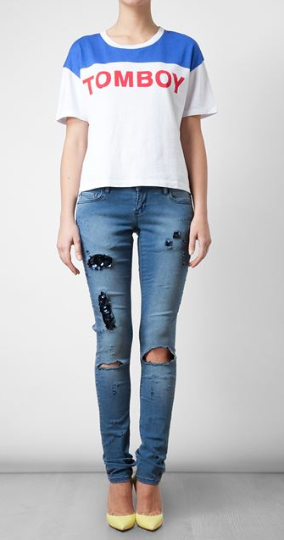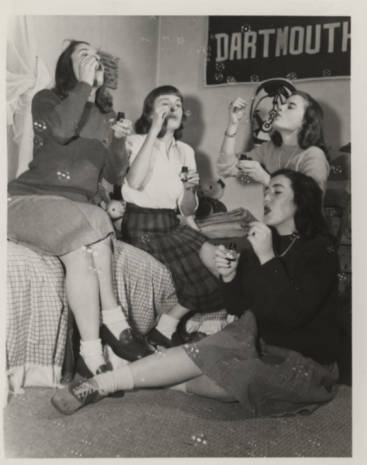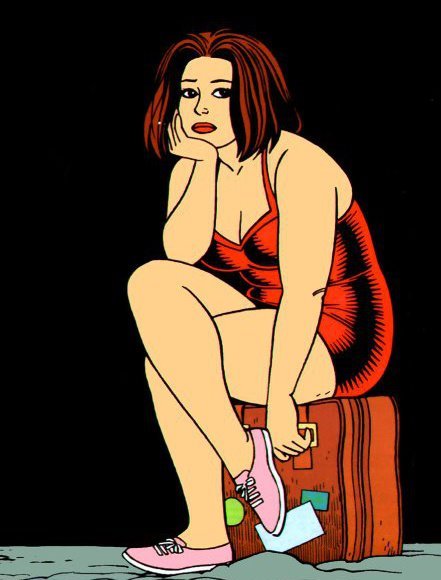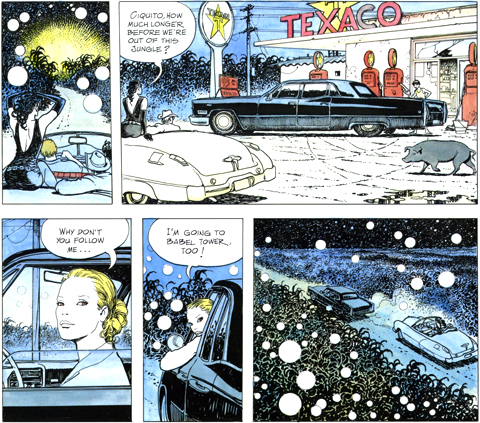2014 was a stepping-back-from-trends year for me, but I can’t say I wasn’t warned. In a downtown cafe in Wellington, late last summer, a woman walked in, rolling her bicycle. Beneath her fine-boned face and giant Paris Hilton sunglasses, her T-shirt declared: TOMBOY.
Only the way that TOMBOY felt the n eed to declare herself with large letters was a surprise. New Zealand has been one of the global incubators of both tomboy style and “sporty luxe”, two trends that went worldwide in 2014. A sporty, one-of-the-blokes attitude has long been rewarded in NZ, extending to dress and grooming. Even when Lorde dons lipstick, or New Zealand high fashion, it’s dark and defiant. Lorde’s column-of-concealing-black is the latest link in the dark chain chronicled in Black: The History of Black in Fashion, Society, and Culture in New Zealand.
eed to declare herself with large letters was a surprise. New Zealand has been one of the global incubators of both tomboy style and “sporty luxe”, two trends that went worldwide in 2014. A sporty, one-of-the-blokes attitude has long been rewarded in NZ, extending to dress and grooming. Even when Lorde dons lipstick, or New Zealand high fashion, it’s dark and defiant. Lorde’s column-of-concealing-black is the latest link in the dark chain chronicled in Black: The History of Black in Fashion, Society, and Culture in New Zealand.
About the time the TOMBOY appeared, the New York Times feverishly discussed the increasing casuality in clothing and women – women over 30, reading between the lines – backing away from fussy clothing. Cathy Horin sums it up: “Lately I’ve noticed many more women, all of them in the zone of careers and complicated family routines, all of them with an eye for fashion, gravitating toward an almost boyish uniform of slim-cut trousers, pullovers and flat shoes. Or a leather jacket with bland layers underneath. They’re hardly wearing makeup, so their complexions look fresh…”
Robin Givhan expands her gaze: “But this is also the new norm. Fashion is technical, pragmatic, and cool, full of swagger and confidence. Everyone wants to look strong and capable. Everyone can be pretty if they like. The concepts of masculinity and femininity are in flux. Whom do you love?”
One of my favorite fashion bloggers recently declared that she is turning towards androgynous/rocker chic, and her new standard for whether she wants to wear a garment is, “Is this something a badass would wear?” Others veer towards simplicity because, currently, it sounds smarter – you’re saving your decision-making for more important things in your life than what you’re wearing. If Steve Jobs’ turtleneck isn’t for you, there’s always Project 333 to narrow yourself down to a small capsule wardrobe. The more exquisitely curated and artisanal, the better.

Autumn 2015 trends are coming and resistance is useless. Left to right: COS (the new upscale H&M spinoff), a woman with enough warmth and verve to make a boxy gray sweater look appealing for fall, and Celine. I’ll just retreat to the back car of Snowpiercer now, where I belong.
2014’s minimalism with a side of androgyny isn’t going anywhere in 2015. It has its benefits. Running a small wardrobe makes it easy to drop a style and recreate your look with a new aesthetic, or, for the anti-consumerist, to rewear favorites constantly. Tomboys and butches are getting the spotlight they deserve. It’s easy to adopt this style on a budget. One of my favorite blogs recently discussed the expansion of tomboy style, which I support one thousand percent. But I worry that there will be an anti-femme backlash. If this new turn really was about nothing but comfort, we’d still all be in our jersey dresses from 2006. And men would be joining us. Something else is up.
In mid-2013, the future got started. We were hearing about the new Soylent, Leaning In, and phones we wear on our wrists, and Piketty’s polarizing Capital in the 21st Century made its quiet August 2013 debut. Compared to the last decade, this one is looking stripped down. I’m not surprised that many of us are recoiling from a culture of constant, ornamented regard. (All this black and white and colorblocking, is it our subconscious attempt to disrupt CCTV surveillance?) Dressing in comfortable androgyny has many practical advantages in 2015 - flatter, thicker-soled shoes, looser clothes, neutral colors, and less makeup are easier in dramatic climate-change weather, more affordable to maintain when times are tight.
2014 was also a year of women’s and queer rights advances and setbacks, and acrimonious dialogues about feminism. High femme style for women drops off when feminist discourse and social changes accelerate. Will being busty, curly-haired, big-eyed, wearing orange and pink and lace, be denigrated as unintellectual and inappropriately uncontrolled? “To fuss and preen. That seems silly, somehow, weak.” I’ve been in that space before: it was called The 1990s. The popular blogger Vixen Vintage recently wrote about both backing away from high-femme vintage wear because of sexualized reactions to it, and about her thoughts on using vintage culture as escapism.
Nonetheless, in cultures of restraint, it takes courage to express excess. Us femmes have to deal with the dichotomy of what we should be – recycling clothes, repudiating brands, wearing intelligent neutrals that all go with each other, somehow “doing what we love” while also “disrupting” some paradigm or other, those damn kale smoothies – and what we want – the shimmer of the new, of self-expression, a long sunny spring day with children or with solitude and a cat, the kale served up in caldo verde soup.
So, with culture having put high femme on the shelf for last year and probably this year as well, it’s a good moment for our research laboratories here at Ever So Scrumptious to formulate the next femme. Femme version 3.0.
First, it’s useful to define Femme 1.0 and 2.0. I see Femme 1.0 as femme-ness expressed through modernity from 1918, the end of World War I, to 1965. There is no “femme” without an alternative or an opt-out – it is never femme if it’s mandatory – and it was in the 20th century that high femme became a choice, mirrored by ever-expanding androgynous options for women. Even in the 50s there were pared-down Katherine Hepburn, bobby-soxer, and bohemian options. Femme 1.0 had queer and feminist bug fix releases throughout the later 60s and the 70s, and was then withdrawn from the market for Pangender Disco Glam.
Femme 2.0, I place from September 11th, 2001 to mid-2013 – see my previous pieces Cupcakes Against The Abyss and Relaxed With A Chance of Apocalypse. We were sifting through the ample female-signifier artifacts of the last century and turning up the dial to create something hyper-feminine. 1950s dresses for everyone, eyelash extensions, hair extensions, a billion red lipsticks, cupcakes, and difficulty in buying a woman’s T-shirt that wasn’t blinged. This was the time of the burlesque scene and the pin-up photographer. Femme 2.0’s riches included feminist body positivity, carving out a place for self-care and women’s friendships in increasingly frantic times, and the sheer fun of swirling skirts. But after a dozen years of Femme 2.0, recursiveness has set in. The cupcakes are getting stale if Femme 2.0 can be parsed this tidily:

Pin-up femme formula: feminine beauty for everyone, or boring style cloning?
If you’re in the radiant red heart of pin-up, enjoy it – it’s delightful for a while to experience the attention and joy. But I have observed that the pin-up flowering lasts for an average of five years for many femmes I know, and what happens next is interesting.
Femme 3.0 is what I see happening next. Femme 3.0 is just as deliberate, but more knowing. Philosophically, it retains the steely feminist undercurrent of previous femme defiance. There’s more talking and arguing than in Femme 2.0 – technology makes feminist issue discussion everyone’s fight. No, I am not going to shut up, and I bet neither are you.
For style, Femme 3.0 relaxes, a little. It gets more creative and edgy than out-to-please pin-up. I picture, in wistful Pinterest-browsing moments, remixing the best of Femme 2.0’s advances and vintage loves into a subtle, aware, and maintainable approach that is still highly feminine. That’s the idea. In actuality, I have never been this busy in my life when I wasn’t at a university, and taking ten minutes to polish myself up in the morning, or once a week, gives me more backbone for my day. Enough that it’s worth the decision-making ergs.
Two lovely inspirations towards Femme 3.0 style.
Femme 3.0 also has values. For myself, making a conscious decision to retain femmeness while moving with the century, I choose these as my essential feminine qualities:
Valuing the femme gaze. The male gaze? That’s so 20th century. Now that everyone is seen all the time anyway, the regard of a feminine woman has gained a curious power, a value for being in short supply. The key to the popularity of Pinterest is the ability to share our gazes – even porn has changed to prioritize webcam exchanges where a woman sees and talks back to the porn consumer (NSFW link here). I resolve to value my own gaze/time/attention, and that of other women.

Resolution for 2015: I will only make cupcakes if they are explosive cupcakes.
Generosity. When our regard, and its aural parallel, our listening space, are valuable, sharing them is a gift – a way in which we are generous. Another part of generosity is recognizing privileges in these difficult times, carrying them lightly, taking nothing for granted, and respecting the stories of others.
Reveling in tech. In 1954 an accomplished woman could do social dancing. In 2014 an accomplished woman can get the wireless rebooted. Ironically, I couldn’t go to not one, but two, Geek Girl Dinners in 2014 because I was providing after-hours tech training.
Inhabiting the body. There are many diet and exercise extremes right now, and endless voices telling us what we should do and how we should be in our skins. Worse, there is endless distraction from being in our own bodies. I’m exiling devices from my bedside to get my sleep back, and working on diet and exercise during my tech work days.
Style keynote: individuality. Scrolled with tattoos, dressed in homemade garments, adorned with a perfect artisanal jewel, touched with mystifying fragrance, inspired by phases of the moon or a favorite molecule, dressing for one’s own features and desires, in sliding fabrics of flattering colors. And lipstick. They’ll pry lipstick out of my cold, dead hands.
Literacy and history. There’s still so much to learn and read and watch. A friend visited me over the holidays and it turned out we had each – as Americans – read parallel sets of 20th-century British women writers. “Why is it that I haven’t heard of Barbara Pym and you’ve never read Cold Comfort Farm?” This is just an example. Here’s hoping I have 53 more years ahead so I can get through some of it.
And remember: you’re a closed circuit, baby. You’ve got the answers in the palms of your hands.
 A literary recommendation: this substantial essay by writer Ellis Avery, The Sapphire and the Tooth. It’s a short, heart-opening read about difficult family, survival, and selling jewelry in the Diamond District of New York City. Many of you will also love her novel The Last Nude, set in the jaded milieu of 1920s Paris, packed with lush dressmaking, transgressive romance, and the paintings of Tamara de Lempicka.
A literary recommendation: this substantial essay by writer Ellis Avery, The Sapphire and the Tooth. It’s a short, heart-opening read about difficult family, survival, and selling jewelry in the Diamond District of New York City. Many of you will also love her novel The Last Nude, set in the jaded milieu of 1920s Paris, packed with lush dressmaking, transgressive romance, and the paintings of Tamara de Lempicka.












 Horrified: In the fashion spotlight: all the clothing we’re not wearing.
Horrified: In the fashion spotlight: all the clothing we’re not wearing. 
